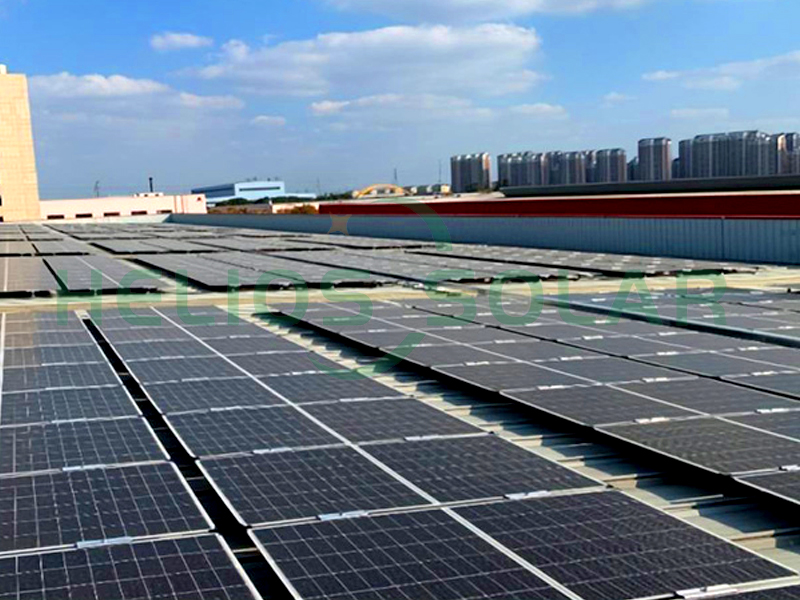As the world increasingly turns to renewable energy sources, solar power has become a leading contender in the search for sustainable energy solutions. Among the various types of solar panels on the market, monocrystalline solar panels are often highly regarded for their high efficiency and performance. This article delves into the complexities of monocrystalline solar panel efficiency, exploring what it is, how it compares to other types of solar panels, and the factors that influence its performance.
Understanding Monocrystalline Solar Panels
Monocrystalline solar panels are made from a single continuous crystal structure, usually silicon. The manufacturing process involves cutting thin wafers out of the silicon monocrystalline, resulting in a uniform and highly pure material. The distinctive dark color and rounded edges of monocrystalline panels are a clear sign of their structure. One of the main advantages of monocrystalline solar panels is their efficiency. In this context, efficiency refers to the percentage of sunlight that the panel can convert into usable electricity. Monocrystalline panels typically have higher efficiency ratings than polycrystalline and thin-film silicon panels, making them a popular choice for residential and commercial facilities.
Efficiency Ratings:
What to Expect Monocrystalline solar panels typically have efficiency ratings above 15% to 22%. This means that they can convert 15% to 22% of the sunlight that shines on them into electricity. The most efficient models on the market can even exceed 23%, a major achievement in solar technology. In comparison, multicrystalline solar panels typically have efficiency ratings between 13% and 16%, while thin-film panels are typically below 12%. This huge difference in efficiency is why monocrystalline panels are often better suited for space-constrained facilities, such as rooftops, where maximizing energy output is critical.
Factors Affecting the Efficiency of Monocrystalline Solar Panels
Several factors affect the efficiency of monocrystalline solar panels, including:
1. Temperature Coefficient
The temperature coefficient of a solar panel represents the degree to which its efficiency decreases as the temperature increases. Monocrystalline panels typically have a lower temperature coefficient than other types of panels, meaning they perform better at high temperatures. This feature is especially beneficial in warm climates, where overheating can affect the performance of less efficient panels.
2. Material Quality
The purity of the silicon used in monocrystalline panels plays a major role in their efficiency. Higher-quality silicon with fewer impurities allows electrons to flow better, resulting in higher energy conversion rates. Manufacturers that focus on quality control and use advanced production techniques tend to produce more efficient panels.
3. Design and Technology
Innovations in solar technology, such as half-cut cell designs and bifacial panels, have further improved the efficiency of monocrystalline solar panels. Half-cut cells reduce resistive losses and perform better in low-light conditions, while bifacial panels capture sunlight from both sides, increasing overall energy output.
4. Mounting and Orientation
The efficiency of a monocrystalline solar panel can also be affected by how it is mounted. Proper orientation and tilt can maximize sunlight, while shading from nearby trees or buildings can significantly reduce energy output. Ensuring that the panels are installed in optimal conditions is essential to achieving their maximum efficiency.
Advantages of Monocrystalline Solar Panels
The high efficiency of monocrystalline solar panels offers several advantages:
Space Efficiency:
Due to their higher efficiency rating, monocrystalline panels require less space to produce the same amount of energy as other types of panels. This makes them ideal for urban environments or properties with limited roof space.
Longevity:
Monocrystalline panels typically have a longer lifespan, often exceeding 25 years. Many manufacturers offer warranties that reflect this durability, giving consumers peace of mind.
Aesthetic Appeal:
The sleek, uniform appearance of monocrystalline panels is often considered more visually appealing than other types, making them a popular choice for residential installations.
Conclusion
The efficiency of monocrystalline solar panels is a key factor in the decision-making process for homeowners and businesses investing in solar energy. With their high efficiency ratings, superior performance in a variety of conditions, and long service life, monocrystalline panels are a leading choice in the solar energy market. As technology continues to advance, we can expect further improvements in the efficiency and performance of monocrystalline solar panels, making them an even more attractive option for those seeking to harness the power of the sun. Whether you’re considering installing solar for your home or business, understanding the benefits and efficiency of monocrystalline solar panels can help you make an informed decision that aligns with your energy needs and sustainability goals.
Post time: Nov-13-2024


